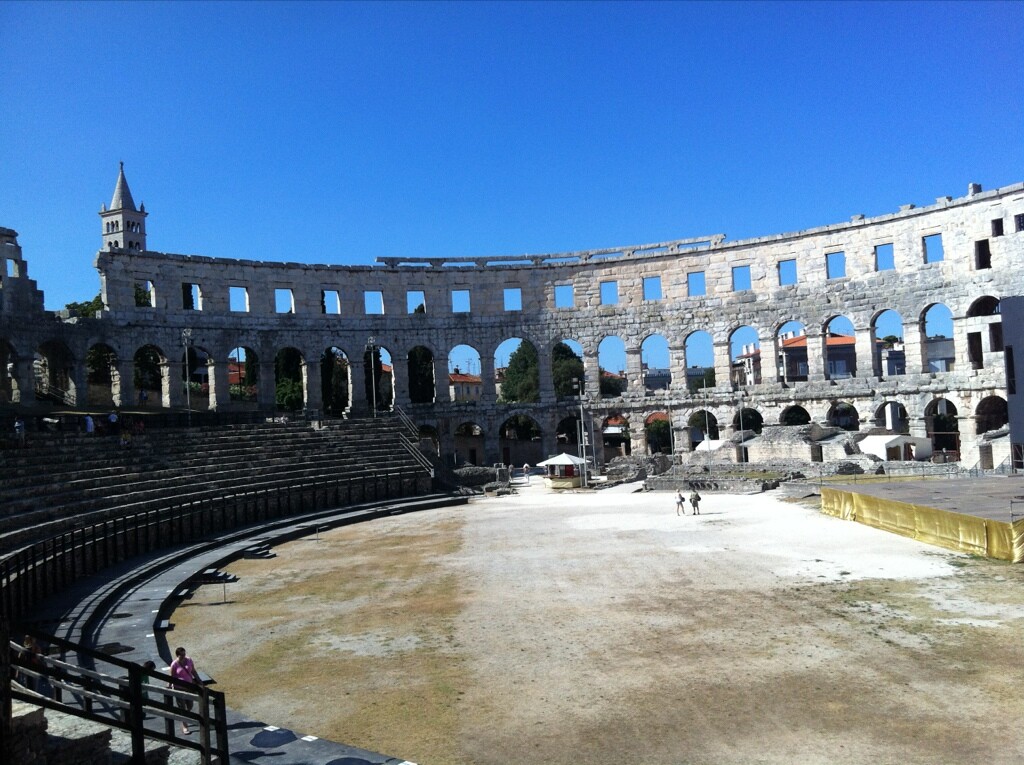Everyone loves Venice, but after a few days, especially at the height of the tourist season, you may feel the need to escape the crowds and try something completely different. Have you considered visiting Pula in Croatia? Yes, it is in another country, but it is very easy to reach from Venice by car (in under 4 hours), bus (about 5 hours) or by high-speed ferry (less than 3 hours, but unfortunately only operating during the summer). The pretty town of Pula lies at the southern-most tip of the Istria peninsula and has a very rich and interesting history, many beautiful protected beaches with crystal-clear water, a mild climate and many unspoiled spots to enjoy nature.

What to do in Pula
Historic Sights:
Pula has been around since Roman times, (ancient Polensium) and there is a wealth of remarkably well-preserved buildings dating back to this period. The most impressive of them all is the Arena, a Roman Amphitheatre which overlooks the harbour, and is the 6th largest surviving amphitheatre from the Roman Empire. This very large structure dates from the 1st-century and could accommodate 20 000 spectators who came to watch the gladiators fight to the death. The 30mt high outer wall has survived almost entirely and contains two rows of 72 arches – it is most impressive and imposing. These days, people come to the amphitheatre to enjoy pop and classical concerts in summer and the Croatian film festival is held there every year in July. What a wonderful setting!
After exploring the Arena, you should take a walk towards the centre of the town to see the Arch of the Sergii, a Roman triumphal arch, before going to see the Temple of Augustus, a Roman temple built to honour the first Roman emperor. This is the only one of a group of three temples to have survived until today, although it required extensive reconstruction after WWII when it received a direct hit and was severely damaged. There are also some remaining ruins of the Temple of Diana.
Beaches: Pula has over a hundred km of coastline with some superb beaches waiting to be discovered. The beaches are generally pebbly, unfortunately, but at many beaches concrete terraces have been built out to the edge of the water, so that you can slide into the clear, warm Adriatic sea without walking over the pebbles! The one exception is the Bijeca Beach in Medulin, where there is a sandy stretch, making this the best beach for children. Some of the best other beaches are in Punta Verudela, Banjole, Fazana and Premantura. If you have your own transport just drive along the beautifully scenic coast and find your own favourite beach. Many water-sports are available, such as windsurfing, kayaking and snorkelling.
Accommodation in Pula: Pula has plenty of accommodation for visitors and you will find many hotels all along the coast, and some excellent luxury resorts, and a few hostels. The mild weather makes camping in Pula very popular; there are several campsites right on the beach for campers to enjoy.
Food: Pula has an interesting selection of restaurants where you can sample the local Istrian cuisine, which is a bit of a fusion of Italian and Croatian traditional dishes, with a large emphasis on fish and meat, while pork, seafood and wine feature very prominently. (Many local wines are produced in Istria and you can drive along the Istrian Wine Roads and visit some of the cellars if you enjoy wine). There are plenty of family-friendly restaurants, making Pula an ideal holiday destination for families.


